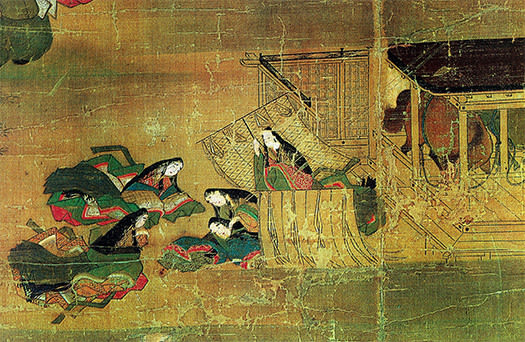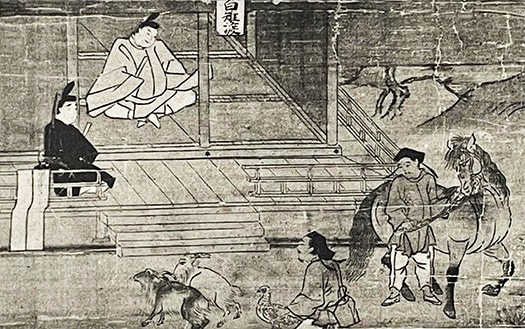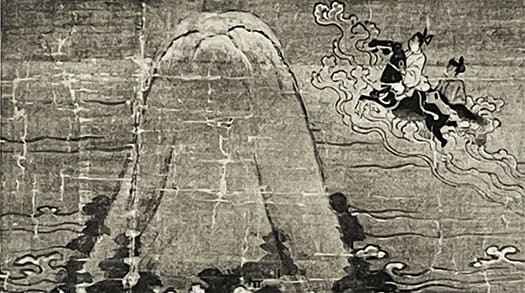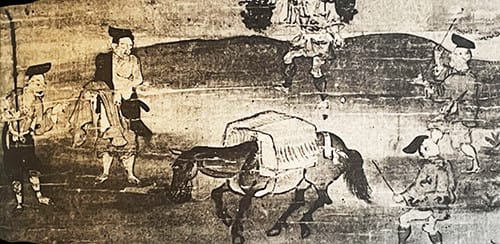



法隆寺宝物館「聖徳太子絵伝」記事、第12回目は「厩戸王」=聖徳太子の出生時の場所と動物の深い縁について。このシリーズの第一回はこちら→端正なモダニズム「法隆寺宝物館」探訪。
西洋ではキリスト教が宗教文化として広く信仰されているけれど、よくキリスト生誕の場が馬小屋・家畜小屋に強い縁があるとされている。そのことは日本人としてそれほど興味を持ってはいないけれど、聖徳太子が別名でその出生時の場所が「馬小屋」であったことから厩戸王と名付けられたことは常識レベル。そして、キリストと聖徳太子の縁起に類縁性があることに興味を持っています。
上の絵は聖徳太子生誕の場面描写で、右側に馬が描かれている。「おお、この場所でか」とにわかな産気づきに驚く侍女たちの様子が人間的共感を呼ぶ。
聖徳太子の事跡が法隆寺で聖徳太子絵伝として描かれた時代は1069年とされている。この時代に、キリスト教世界との対比性を意識することはあり得ただろうか、と考えると腑に落ちない。
たしかに後世の聖徳太子信仰によって脚色が増えていくことは当然としても、名前については事実だろうから、キリストとの類似性を強調する蓋然性は乏しいと思う。日本社会の受け取り方としては、旺盛に西洋と接触した戦国期・大航海時代まではキリストに強い興味を持っていたとは考えにくい。
2番目の絵は太子28才の時に百済から贈られた「駱駝・驢馬・羊・白雉」の図。そして富士登山でも黒駒に乗馬して登っている。動物との縁の深さを印象づけられる。さらにのちには、遠方から荷を背負って都まで旅していた馬が沿道の稲を食べてしまい、それを怒った農民が馬主とその馬を打ち据えていたのを,聖徳太子は静かに諭したという説話もある。「たまたま現世では畜生に生まれているけれど、しかし人間も同じイキモノなのだから、憐れみこころを持ちなさい」と。

どうも、動物愛護の精神は聖徳太子には満ちあふれていたことが伝わってくる。出生時の機縁から厩戸王と名付けられたことにも、かれ自身は深く受容し、そのことに愛情も持っていたように感じられる。
こういった自然な受け取り方からすると、キリストとの類似性はやはり偶然性が高いのだろう。むしろ西洋世界とコミュニケーションを活発にするようになって、キリストとの類似性がわかって、日本社会、仏教の側でも太子信仰により加速度が加わったのではないか。
宗教という精神性の核心に動物愛護のこころは非常に親和性高く存在しているのでしょうか。2番目の絵での太子の動物たちを見つめる目線にはいかにもそういったこころが感じられる。
English version⬇
King Umayato-oh, Prince Shotoku, Christ, and the Spirit of Animal Protection The Gallery of Horyuji Treasures-12
The similarity between the birthplace of Christ and the birthplace of Prince Shotoku. Are there similarities between religious beliefs and the spirit of animal protection? ...
The twelfth article in the Horyuji Treasure Museum's "Shotoku Taishi Eaden" series, "King Umayato" = Shotoku Taishi's place of birth and his deep connection to animals.
In the West, Christianity is widely believed as a religious culture, and it is often said that the birthplace of Christ has a strong connection to a stable or livestock barn. As a Japanese, I am not so interested in this fact, but it is common knowledge that Prince Shotoku was named "King Umato-oh" because the place of his birth was a "stable" under an alias. And I am interested in the parallels between Christ and Shotoku Taishi's auspiciousness.
The picture above is a depiction of the scene of Prince Shotoku's birth, with a horse on the right. The scene of the maidens' surprise at the birth of Shotoku Taishi, which is depicted on the right side of the painting, evokes human sympathy.
The date of the depiction of the birth of Prince Shotoku in the picture biography of Prince Shotoku at Horyuji Temple is believed to be 1069. It is hard to understand how anyone could have been aware of the contrast with the Christian world at that time.
It is true that the later belief in Shotoku Taishi led to the use of more and more legends, but the name is a fact, so there is little probability that the similarity with Christ would be emphasized. In terms of the reception of Japanese society, it is difficult to believe that they had a strong interest in Christ until the Warring States Period and the Age of Exploration, when they had vigorous contact with the West.
The second painting is of a camel, ass, sheep, and white pheasant, a gift from Baekje when the prince was 28 years old. He also rode a black horse up Mt. This shows the depth of his connection with animals. Later, there is a story that a horse traveling to the capital with a load on its back from a distant place ate rice along the way, and that when angry farmers beat up the owner and his horse, Prince Shotoku quietly admonished them. Prince Shotoku quietly admonished them, "Though you happen to be born as a beast in this life, you should have compassion for humans because we are all animals in the same way.
This tells us that Prince Shotoku was full of the spirit of animal protection. He himself seemed to have deeply accepted and loved the fact that he was named "King Umato-oh" (King Umato-oh) because of the circumstances of his birth.
From this natural reception, the resemblance to Christ is probably highly coincidental. Rather, it is likely that the discovery of the similarity with Christ, as a result of their active communication with the Western world, accelerated the Taishi faith in Japanese society and on the Buddhist side.
The way the Taishi gazes at the animals in the second painting suggests such a spirit.



















